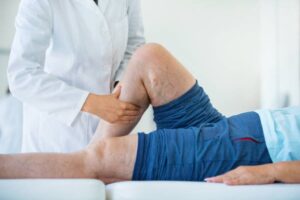Varicose veins are a common vascular condition that affects millions of people worldwide. These enlarged, twisted veins not only cause discomfort but can also lead to complications if left untreated. Luckily, advancements in medical technology have led to the development of minimally invasive varicose vein treatment options that offer effective relief with fewer risks and shorter recuperation times than traditional surgical procedures. This article will talk about the different minimally invasive ways to treat varicose veins, giving readers a full picture of these new methods.
Understanding Varicose Veins:
 Before delving into treatment options, it’s essential to grasp the basics of varicose veins. Venous valves that don’t work correctly can lead to varicose veins. This happens when blood pools in the veins, making them look bigger. Risk factors for getting varicose veins include genetics, getting older, being overweight, being pregnant, and standing or sitting for long periods. Although varicose veins are usually thought of as an aesthetic problem, they can also make the affected arms hurt, swell, itch, and feel tired.
Before delving into treatment options, it’s essential to grasp the basics of varicose veins. Venous valves that don’t work correctly can lead to varicose veins. This happens when blood pools in the veins, making them look bigger. Risk factors for getting varicose veins include genetics, getting older, being overweight, being pregnant, and standing or sitting for long periods. Although varicose veins are usually thought of as an aesthetic problem, they can also make the affected arms hurt, swell, itch, and feel tired.
Minimally Invasive Treatment Options:
- Endovenous Laser Ablation (EVLA): Endovenous laser ablation, also known as endovenous laser therapy (EVLT), is a minimally invasive process used to treat varicose veins in the legs. During EVLA, a thin laser fibre is inserted into the affected vein under ultrasound guidance. The laser emits heat, causing the vein to collapse and seal shut. Over time, the body naturally engrosses the treated vein, rerouting blood flow to healthier veins. EVLA is performed on an outpatient basis and typically requires minimal downtime, allowing patients to resume normal activities shortly after the procedure.
- Radiofrequency Ablation (RFA): Radiofrequency ablation is another minimally invasive technique used to treat varicose veins by delivering thermal energy to the affected vein. Similar to EVLA, RFA involves inserting a catheter into the diseased vein, where radiofrequency energy is then applied to heat and close the vein. As with EVLA, RFA is performed under ultrasound guidance and offers a high success rate in eliminating varicose veins while minimising discomfort and recovery time.
- Sclerotherapy: One of the sought-after varicose vein treatment options is sclerotherapy, which is a minimally invasive procedure commonly used to treat small varicose veins and spider veins. During sclerotherapy, a resolution called a sclerosant is injected directly into the affected vein, causing irritation and inflammation of the vein wall. This leads to the closure of the vein, which is eventually absorbed by the body, resulting in improved blood flow and diminished visibility of the vein. Sclerotherapy is typically performed in a physician’s office and requires little to no downtime, making it a convenient option for patients with milder forms of venous disease.
- Ambulatory Phlebectomy: Ambulatory phlebectomy is a marginally invasive surgical procedure used to remove surface varicose veins through tiny incisions or perforations in the skin. Unlike traditional vein-stripping surgery, ambulatory phlebectomy involves the targeted removal of bulging veins using specialised hooks or microsurgical instruments. This technique is often performed under local anesthesia and allows for precise removal of varicose veins with minimal scarring and downtime.
Benefits of Minimally Invasive Treatment:
Minimally invasive options for varicose vein treatment offer several advantages over traditional surgical procedures. These benefits include:
- Reduced Risk: Minimally invasive techniques involve smaller incisions, leading to a lower risk of complications such as infection, bleeding, and nerve damage.
- Quicker Recovery: Compared to open surgery, minimally invasive procedures typically require less downtime, allowing patients to return to their normal activities sooner.
- Minimal Scarring: Minimally invasive techniques result in smaller scars or puncture marks, preserving the aesthetic appearance of the skin.
- Outpatient Setting: Many minimally invasive procedures can be performed on an outpatient basis, eliminating the need for hospitalisation and reducing healthcare costs.
- High Success Rate: Minimally invasive treatments have been shown to effectively eliminate varicose veins and provide long-lasting relief from symptoms.
Minimally invasive varicose vein treatment options offer safe, effective, and convenient alternatives to traditional surgical interventions. From endovenous laser ablation to sclerotherapy, these innovative techniques provide patients with relief from the discomfort and aesthetic concerns associated with varicose veins. By understanding the various minimally invasive treatment preferences available, individuals can make well-versed decisions about their vascular health and take proactive steps toward improving their quality of life. If you are undergoing symptoms of varicose veins, consult with a qualified vein specialist to explore the most appropriate treatment approach for your unique needs.

 Stroke rehabilitation encompasses a multidisciplinary approach, with physiotherapy playing a central role. The primary goal of physiotherapy in stroke rehabilitation is to enhance motor function, mobility, and balance while addressing any associated impairments. Each survivor presents a unique set of challenges, requiring individualized treatment plans tailored to their specific needs and goals.
Stroke rehabilitation encompasses a multidisciplinary approach, with physiotherapy playing a central role. The primary goal of physiotherapy in stroke rehabilitation is to enhance motor function, mobility, and balance while addressing any associated impairments. Each survivor presents a unique set of challenges, requiring individualized treatment plans tailored to their specific needs and goals. When choosing a medical clinic, it is essential to know the fees that will be charged. It will help you avoid any surprises later on. You should also check whether or not your insurance plan covers your needed services. It will help you save money and time.
When choosing a medical clinic, it is essential to know the fees that will be charged. It will help you avoid any surprises later on. You should also check whether or not your insurance plan covers your needed services. It will help you save money and time. The professionals at this centre are well-equipped with the latest chiropractic techniques to provide a holistic approach to their clients. They believe the body knows what it needs for healthy functioning, so they focus on restoring the spine to its normal condition. They offer a wide range of services to treat different ailments. You can book your appointment online or give them a call directly.
The professionals at this centre are well-equipped with the latest chiropractic techniques to provide a holistic approach to their clients. They believe the body knows what it needs for healthy functioning, so they focus on restoring the spine to its normal condition. They offer a wide range of services to treat different ailments. You can book your appointment online or give them a call directly. A hammer toe is a deformity of the lesser digits (toes) that causes them to bend downward like a hammer instead of lying flat. It usually develops in the second, third or fourth toe and worsens over time if left untreated. It is one of the most common foot problems and can result in pain, corns and calluses. People with certain medical conditions, such as diabetes or rheumatoid arthritis, are more likely to develop hammer toes.
A hammer toe is a deformity of the lesser digits (toes) that causes them to bend downward like a hammer instead of lying flat. It usually develops in the second, third or fourth toe and worsens over time if left untreated. It is one of the most common foot problems and can result in pain, corns and calluses. People with certain medical conditions, such as diabetes or rheumatoid arthritis, are more likely to develop hammer toes. If you have diabetes, you must check your feet regularly to prevent serious foot problems.
If you have diabetes, you must check your feet regularly to prevent serious foot problems.